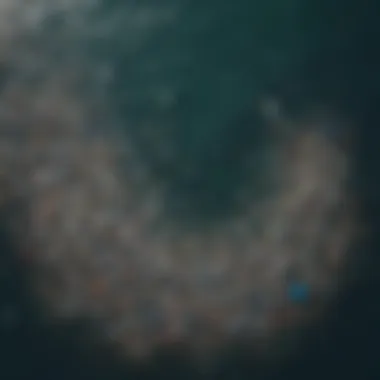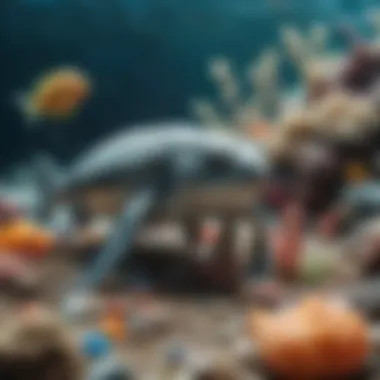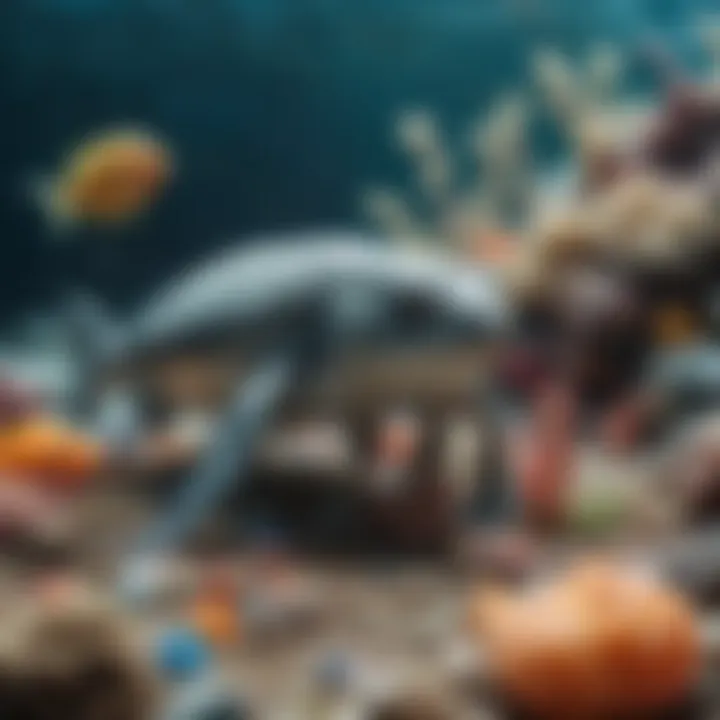Exploring the Origins of Oceanic Plastic Pollution


Intro
Plastic pollution in our oceans isn't just a distant problem; it's a story woven into the very fabric of modern living. From the plastic bags that accompany our groceries to the microbeads hidden in beauty products, these materials find their way into marine ecosystems with disconcerting ease. Understanding how this happens opens the door to solutions, enabling individuals and communities to take meaningful action.
As the tide of plastic waste surges, it's critical to examine the multiple sources contributing to this environmental crisis. Land-based activities, such as mismanaged waste, play a significant role, while maritime practices can also exacerbate the situation. Each piece of litter drifting on ocean currents tells a tale, one that echoes the choices of consumers and the decisions of industries, not to mention the policies that govern waste management.
"The ocean is the ultimate sink, absorbing what we throw away, regardless of the source."
This article aims to delve into the origins and pathways of plastic pollution, emphasizing the multifaceted complexity of this issue and the urgent need for concerted efforts to mitigate its effects. The interconnectedness of our choices and their far-reaching impact on marine life cannot be overstated, making our understanding all the more essential.
Preamble to Ocean Plastic Pollution
Plastic pollution in our oceans isn't just a buzzword; it’s a looming crisis that requires our immediate attention. With rivers and streams acting like arteries that feed into the sea, the progression of plastic waste is a tale as old as time—or at least since the advent of synthetic polymers. Water sports enthusiasts and outdoor adventurers are acutely aware of the allure of unpolluted marine environments. Yet, as we paddle, surf, or sail across these stunning expanses, the hidden dangers of plastic waste lurk beneath the waves, threatening ecosystems and human health.
As we dive deeper into this topic, it’s essential to recognize the sheer volume of plastic that ends up in our oceans, affecting not only the delicate balance of marine life but also the outdoor activities we hold dear. According to estimates, millions of tons of plastic make their way into the ocean every year, suffocating flora and fauna, and disrupting food chains.
The sources of this plastic are incredibly varied, a mixed bag of industrial waste, consumer mismanagement, and even natural events. The sheer intricacy of this problem requires a multi-faceted understanding. By grasping where this waste originates, outdoor enthusiasts can become advocates for cleaner practices, beit in their own habits or in promoting policies that mitigate such pollution.
Here, we will unpack critical elements surrounding oceanic plastic pollution. The significance of this topic extends beyond the academic; it’s about preserving the places we love and ensuring that future generations can experience the same pristine waters. The tug of war between our habits and environmental responsibility is ongoing, and this article seeks to shed light on the challenges we face in preventing plastic pollution from taking its toll on our precious oceans.
"The oceans are a mirror reflecting our deepest values and behaviors; each piece of plastic floating in the water is a reminder of what we’ve allowed our practices to become."
This notion not only captures the gravity of the situation but also implores us to think critically about our consumer behavior and cultural attitudes towards material usage. Through careful examination of land-based and maritime sources of plastic, this article aims to empower our audience to take a stand against pollution, promoting an awareness that translates into action—both on the shores we cherish and in the broader context of global environmental health.
Thus, as we embark on this exploration, let us recognize the importance of understanding the sources of ocean plastic pollution. It isn’t merely an environmental concern; it’s a call to each of us who takes to the waves, a reminder that every small action can contribute to a larger, meaningful change.
Overview of Plastic as a Material
Plastics are ubiquitous in modern life, extending far beyond just convenience; they also shape how our society operates. The importance of understanding plastic as a material lies in its diverse applications and the environmental challenges it poses. As a powerful enabler of innovation, plastic has been integral in various industries—from packaging to healthcare—offering significant benefits due to its durability, flexibility, and lightweight nature. However, this very versatility and its often cheap production costs contribute to its pervasive presence in the oceans.
Properties of Plastic
Plastics come in various forms, each with unique properties, making them suitable for different uses. Some of these properties include:
- Durability: Plastics can withstand harsh conditions, which is an asset in many applications; however, it also means that plastic waste does not decompose easily in the environment.
- Lightweight: This property facilitates easy transportation and handling. Yet, it often results in plastics being more prone to being blown away or carried into water bodies.
- Chemical Resistance: Plastics do not react easily with chemicals, which makes them ideal for packaging food and chemicals, but it can also lead to long-term pollution when they break down into smaller particles and release toxins.
These characteristics contribute to the benefits of plastic but also necessitate understanding their impacts on marine ecosystems.
History and Use Cases
The history of plastic traces back over a century, with the first synthetic plastic, Bakelite, emerging in 1907. Since then, plastic has transformed various industries:
- Packaging: One of the major uses of plastic is in packaging products, which helps in prolonging shelf life, reducing food waste, and providing convenience. Roughly 40% of global plastics are used for packaging, accounting for a significant portion of the plastic waste that ends up in oceans.
- Construction: Plastics are often utilized in building materials such as pipes and insulation. Their durability can promote longer-lasting structures, but discarded construction waste can leach into waterways.
- Consumer Goods: Everything from toys to electronics often has plastic components, making it nearly impossible to avoid. While offering a myriad of benefits in production and use, consumer habits around disposal are critical to addressing pollution issues.
"Understanding the properties and history of plastic is fundamental in deciphering its role in oceanic pollution."
Land-Based Sources of Plastic Waste
Understanding the land-based sources of plastic waste is crucial not just for grasping how this environmental crisis came about, but also for identifying effective strategies to combat it. This section places heavy emphasis on the pathways through which plastic makes its way into the ocean, starting from human activities on land. The significance of effectively addressing land-based pollution lies in its potential to significantly reduce the amount of waste that ultimately ends up in marine environments.
By targeting these sources, we can implement changes that resonate within communities, industries, and governments alike. The goal isn’t merely to mitigate the problem but to fundamentally alter the behaviors and policies that encourage such waste generation, thus fostering healthier ecosystems for generations to come.
Urban Runoff and Municipal Waste
Urban runoff is a significant contributor to oceanic plastic pollution. As rainwater flows over impervious surfaces like roads and sidewalks, it collects various materials, including plastics, which often come from litter discarded carelessly by pedestrians or blown from waste containers. This runoff does not just wash dirt and debris; it sweeps a slew of plastic bits into storm drains, thus redirecting them straight to rivers and, eventually, to the ocean.
Municipal waste management systems often fall short in addressing littering issues. Many cities struggle to keep public areas clean and adequately maintain trash facilities. Common plastic items, such as bags, bottles, and straws, can easily escape into the environment. For instance, a single plastic bottle can take hundreds of years to decompose, during which it can break down into microplastics that are even harder to track and manage.
"Urban runoff contributes significantly to the plastic load in our oceans, demonstrating the interconnectedness of land behavior and marine health."
Industrial Discharges
The industrial sector, while often viewed through the lens of economic benefits, also plays a considerable role in feeding plastic pollution into marine ecosystems. Many industries utilize plastic as a crucial component of their production processes, leading to various forms of waste.
From manufacturing plants that utilize plastic packaging to those that produce plastic goods, spillage and improper disposal can lead to significant leakage into the waterways. Moreover, many regulatory frameworks do not sufficiently address the need for stringent defense against plastic emissions. A precise example of such oversight is the unregulated disposal practices at some facilities. Plastics that end up in landfills can become airborne during windy conditions, making their way into nearby drains and ultimately the ocean.


The pressure must be placed on industries to adapt more sustainable practices. Achieving a cleaner production approach involves re-evaluating materials used and seeking alternatives to plastics wherever possible.
Agricultural Practices
Surprisingly, the agricultural sector contributes to plastic pollution as well. The use of plastic for packaging, tarps, and even agricultural products such as fertilizers or chemicals is commonplace. Farmers often utilize plastic mulch films and containers, which, if not disposed of correctly, become prime offenders in the plastic pollution saga.
Additionally, practices involving irrigation systems can lead to significant waste. For instance, broken plastic pipes left unrepaired can lead to plastic fragments entering waterways. Pesticides and fertilizers often come packaged in plastic, which may end up discarded improperly.
Addressing agricultural practices demands a conscious effort towards sustainable farming, where alternatives to plastic are quantifiably integrated. Encouraging farmers to adopt biodegradable options while improving waste management can make a marked difference.
In sum, taking an honest look at land-based sources of plastic waste reveals the pervasive nature of the issue. By focusing on urban runoff, industrial processes, and agricultural methods, we can better appreciate the systemic changes needed to confront this crisis head-on. This deeper understanding paves the way for more informed actions—actions that range from immediate local solutions to broader regulatory reforms.
Maritime Sources of Plastic Pollution
In the discussion of oceanic plastic pollution, maritime sources often find themselves overshadowed by their land-based counterparts. Yet, understanding these sources is crucial, especially considering the unique ways in which they contribute to the plastic crisis that our oceans face.
Maritime activities, especially those involving fishing and shipping, are significant contributors to ocean plastic. Fishing activities alone account for a large segment of oceanic plastic waste, including discarded nets, lines, and traps. These materials not only pollute the water but also create hazards for marine fauna and humans alike. Likewise, the shipping industry, with its extensive global operations, often inadvertently releases plastic through cargo spills, improper waste disposal, and wear and tear on vessels. The sheer volume of maritime traffic compounds this issue, making it an integral focus for addressing the roots of oceanic plastic contamination.
Fishing Activities
Fishing activities rank high as a maritime source of plastic pollution. It's not just the casual fisherman who contributes to this problem; commercial fishing practices, in particular, play a major role. Nets that are lost or abandoned—often referred to as ghost nets—can drift for years, ensnaring marine life and degrading into microplastics while they float adrift.
The magnitude of ghost nets is alarming, estimated to be in the hundreds of thousands of tons. These nets can entrap fish, sea turtles, and even larger marine mammals, leading to unnecessary suffering and death. Aside from the direct impact on wildlife, there's a domino effect: when key species decline, ecosystems become unbalanced.
Some regions have introduced initiatives to recover ghost nets and repurpose them, helping to mitigate this issue. For instance, in places like the Mediterranean, fishermen are encouraged to return lost gear, with various organizations facilitating the collection process.
Take note of these compelling stats:
- Each year, approximately 640,000 tons of fishing gear is left in the ocean.
- Ghost gear is considered one of the most deadly forms of marine debris, encompassing about 46% of the ocean's plastic.
Shipping and Transportation
The shipping and transportation sectors also provide ample contribution to oceanic plastic pollution—a little-known but vast area of concern. With thousands of ships entering ports and cruising the open seas daily, the chances for pollution events are high. From cargo spills to direct waste discharge, it's a complex challenge that the industry struggles to manage.
Unregulated waste disposal practices on ships pose a significant risk, and indeed many vessels still practice outdated disposal methods while at sea, resulting in accidental discharge of plastics into the ocean. Further complicating matters, wear and tear on ship hull paint—often containing microplastics—allows these tiny pollutants to seep into marine environments gradually.
Just to put it into perspective, a study found that a single large cargo vessel can release up to 850 metric tons of microplastics with paint flaking each year.
These facts illuminate the urgent need for stricter regulations and better practices in the maritime sector to curb the plastic flow into our oceans. Marine industry stakeholders are starting to acknowledge the issue, paving the way for innovative waste management solutions and more sustainable practices.
"Addressing the maritime sources of plastic pollution is not just a challenge; it can also be viewed as an opportunity for innovation and sustainability."
Microplastics: The Invisible Threat
Microplastics have emerged as a significant concern in the discussion of oceanic plastic pollution. While larger plastic debris often garners more media attention, microplastics—tiny plastic particles measuring less than five millimeters—pose a pervasive and alarming threat.
One of the primary challenges with microplastics is their omnipresence; they can be found in every oceanic region, from the pristine waters of the Arctic to the depths of the Mariana Trench. Their diminutive size makes them almost invisible to the naked eye, yet their impact is anything but negligible, affecting marine ecosystems and, indirectly, human health.
Sources of Microplastic Pollution
Microplastics originate from a blend of sources, reflective of our consumption and waste products. Some common culprits include:
- Fragmentation of Larger Plastics: As plastic items like bags, bottles, and toys degrade under UV light, they break down into smaller fragments that contribute to microplastic pollution.
- Synthetic Clothing: When washed, fabrics made from synthetic materials—like polyester and nylon—shed tiny fibers during laundering. Studies estimate a single load of laundry can release thousands of microfibers into wastewater.
- Personal Care Products: Many exfoliating scrubs and cosmetics contain microbeads—tiny plastic particles used for scrubbing or as fillers. Despite bans in various regions, these products have contributed massively to oceanic pollution in the past.
Understanding these sources helps underscore the ubiquitous nature of microplastics and the urgency needed in addressing their proliferation.
Effects on Marine Wildlife
Microplastics do not just float aimlessly; they integrate into marine food webs, posing direct threats to wildlife. Fish, birds, and other marine creatures often mistake microplastics for food due to their size and color. As a result, countless species consume these pollutants, leading to serious health issues.
Consider the following ramifications:
- Physical Harm: Ingesting microplastics can cause obstructions in the digestive system of marine animals, leading to malnutrition or even death.
- Chemical Contaminants: Microplastics can attract harmful pollutants like pesticides and heavy metals from the water, which can then enter the bodies of aquatic organisms and magnify through the food chain.
- Behavioral Changes: Emerging research suggests that exposure to microplastics can alter the behavior of marine organisms, affecting their ability to feed, reproduce, or evade predators.
In summary, the dangers posed by microplastics are profound and multifaceted. Their ability to infiltrate our oceans and impact marine life sets a daunting challenge for conservation efforts and underscores the importance of collective action to mitigate this issue.
Human Contribution to Ocean Plastic


The very fabric of modern life is interwoven with plastics, and it’s our daily choices that significantly shape the extent of oceanic plastic pollution. Understanding how human actions contribute to this growing crisis is crucial for unpacking the complex web of factors leading to plastic’s presence in our oceans. By delving into the nuances of consumer behavior and cultural attitudes, we can unveil the root causes that pressure marine environments and ultimately, human health as well.
Consumer Behavior and Waste Management
Consumer habits hold more influence over ocean plastic pollution than many realize. Everyday decisions about what we buy and how we dispose of items can create ripples that extend far beyond our immediate surroundings. When we consider that nearly 80% of the plastic in our oceans originates from land, it’s evident that our purchasing patterns are part of a larger equation.
A few key practices can directly impact these figures:
- Single-use Plastics: Many consumers opt for single-use items without consideration for their lifecycle. Straws, plastic bags, and utensils might seem harmless as we use them, but their disposability contributes immensely to waste.
- Improper Disposal: Failures in waste management systems, coupled with careless disposal practices, amplify the issue. When waste is not sorted or properly disposed of, plastics can easily find their way into water systems, eventually leading to the oceans.
- Lack of Recycling: Although recycling programs are increasingly available, not all consumers partake in them responsibly. Misplaced items in recycling bins lead to contamination, rendering potential recyclable plastics unsuitable for processing.
"Plastic isn't just a material; it represents a fundamental shift in our consumption patterns. It demands that we rethink how we interact with our environment."
Encouraging responsible consumer behavior could drastically alter the trajectory of plastic pollution. Educating individuals on the impact of their choices—be it through workshops or campaigns—fosters a community that is not just passive but proactive in addressing the issue.
Cultural Attitudes Toward Plastic Use
At the heart of personal choices lies cultural attitudes toward plastic. In many societies, there’s a prevailing perception that plastic is convenient and affordable, pushing it to the forefront of consumption. This cultural mindset also subtly supports the normalization of wasteful practices, often with little thought about long-term effects on the environment.
Several factors contribute to these attitudes:
- Societal Norms: In some cultures, using disposable plastics is considered more trendy or modern, which clamps down on initiatives aimed at reducing plastic use. The image of convenience is often prioritized over the environmental cost.
- Economic Incentives: Plastics are typically cheaper than their sustainable counterparts. This affordability can sway consumers, suggesting a societal trend where economic factors hold more value than eco-consciousness.
- Limited Awareness: Many individuals remain unaware of the destructive impact of plastic waste on marine ecosystems. Without education and awareness, the connection between personal actions and global consequences remains tenuous.
To shift cultural attitudes, we must rely on comprehensive education initiatives that emphasize the significance of sustainability. Grassroots movements, coupled with state and local policies, can reshape the narrative around plastic use and encourage communities to adopt more sustainable practices.
The Role of Policy and Regulation
In tackling the intricate issue of oceanic plastic pollution, the role of policy and regulation stands as a foundational pillar. Without a coherent framework guiding actions, the attempts to mitigate this dire problem could easily falter. Established rules and regulations can shape industry practices, consumer behavior, and even influence public perception. Effective policies are not just bureaucratic red tape; they can catalyze meaningful change that resonates deep within our oceans.
Global Agreements and Local Regulations
Marine pollution transcends national borders, necessitating a cohesive collective response to be truly effective. Global agreements like the United Nations' Sustainable Development Goals, specifically Goal 14, aim to conserve and sustainably use the oceans—targeting marine pollution directly. Countries commit to reducing their ocean waste, fostering cooperative efforts to share data and resources.
However, merely signing agreements isn't enough; it’s all about translating these promises into action through local regulations. Local governments play a crucial role by implementing enforceable measures tailored to their unique challenges. For instance, many coastal communities are now instituting bans on single-use plastics, such as straws and bags, drastically reducing waste entering local waterways. This localized approach complements broader policies and creates a layered barrier against pollution.
The dialogue between international goodwill and local action illustrates a vibrant tapestry of responsibility where each piece connects to the larger goal of ocean health. Such regulations not only facilitate collective responsibility but also promote innovation within industries, driving them towards sustainable alternatives.
The Impact of Policy on Marine Health
When examining how policies affect marine health, it becomes clear that robust regulations can transform the landscape of marine environments. Policies aimed at reducing plastic pollution translate directly into healthier ecosystems. They lead to decreased levels of plastic debris, which has shown to harm marine animals in unimaginable ways.
The implementation of marine protected areas (MPAs) is a prime example illustrating the substantial influence policy can have. By designating specific regions of the ocean as restricted from plastic-based activities, countries can help rejuvenate marine biodiversity—offering fish and other sea creatures safe havens to thrive away from the hazards of human-made waste.
Importantly, these impacts aren't just short-term. Effective policies promote long-term benefits:
- Ecosystem Resilience: Healthier marine ecosystems can better withstand environmental stresses.
- Biodiversity Preservation: A reduction in plastic pollution can help preserve various marine species, thus maintaining ecological balance.
- Research and Monitoring: Policies often allocate funding for scientific studies, enhancing our understanding of plastic pollution and its vast impacts.
"Policies should do more than set guidelines; they should foster an environment where innovation leads to practical solutions for ocean health."
As stewardship of the ocean increasingly becomes part of regulatory discussions, the intertwining of policy and marine health continues to be a crucial aspect of ensuring that these vast bodies of water can survive for future generations. Without effective governance, the tangible benefits to marine health would likely dwindle, leaving only traces of what could have been achieved.
Innovative Solutions and Technologies
Understanding the role of innovative solutions and technologies is crucial in the fight against oceanic plastic pollution. These advancements can potentially transform how we approach waste management, packaging, and even the materials we use in daily life. Addressing this issue requires not only identifying the sources of plastic but also exploring viable alternatives and strategies that mitigate the impact on marine ecosystems.
Biodegradable Plastics
Biodegradable plastics represent one of the most promising avenues in the quest to reduce the proliferation of plastic waste in our oceans. Unlike conventional plastics, which can linger for centuries without breaking down, biodegradable options can decompose under specific environmental conditions. This attribute can significantly diminish the long-term impacts of products discarded improperly in marine settings. Nevertheless, it's essential to spotlight that not all biodegradable plastics are created equal. Some may still release microplastics during degrading, which conflicts with the very purpose they aim to serve.
Moreover, biodegradable plastics require particular industrial composting facilities to break down effectively. Thus, even as discussion swirls around implementing these materials, addressing infrastructural limitations is paramount. A holistic solution might entail public-private partnerships to foster the rise of composting infrastructure or stronger policies to encourage responsible production and disposal. Encouraging manufacturers to embrace these eco-friendly substitutes not only benefits marine life but also resonates with consumers increasingly aware of their environmental footprint.
Cleanup Initiatives
Cleanup initiatives are indispensable in the effort to tackle ocean plastic pollution. These actions, ranging from community-led beach cleanups to large-scale marine operations, have shown that collective efforts can yield tangible results. For instance, the work of organizations like The Ocean Cleanup strives to remove plastic from the Great Pacific Garbage Patch using innovative technologies such as massive floating barriers and unique booms that capture debris.
Despite their promise, cleanup initiatives come with challenges. Factors such as weather, local regulations, and the sheer scale of pollution can hamper these efforts. Moreover, they often address the symptoms rather than the root causes of plastic waste. Efforts must focus not just on cleanup but on preventing plastic from entering the ocean in the first place. This includes education campaigns that inspire communities to rethink their relationship with plastic, fostering a culture where reducing waste becomes second nature.


"The ocean is not a dump. It is a vital component of ecosystems and human existence. Without effective cleanup initiatives, we risk losing that which sustains us."
Case Studies of Affected Regions
Understanding the case studies of affected regions is essential in grasping the full scope of oceanic plastic pollution. These case studies not only shine a light on the massive scale of the problem but also reveal the localized impacts of plastic waste on marine ecosystems and human communities. They serve as real-world illustrations of how plastic pollution manifests in different contexts. Insights drawn from these examples can help identify patterns, trigger policy reforms, and bolster community engagement in conservation efforts.
The Great Pacific Garbage Patch
One of the most talked-about illustrations of oceanic plastic pollution is the Great Pacific Garbage Patch. This swirling mass of debris, located between Hawaii and California, continues to be a source of fascination and concern. The patch is not a solid island of trash; rather, it's a thick soup of microplastics, discarded fishing nets, and other debris, encompassing an area twice the size of Texas. This expanse of debris serves as a grim reminder of our collective impact on the oceans.
The origins of the Garbage Patch can be traced back to various sources:
- Urban runoff: Rain can wash plastic waste from streets into waterways that lead to the ocean.
- Shipping lanes: Increased maritime traffic adds to the plastic and other waste entering the Pacific.
- Fishing activities: Lost or discarded nets contribute significantly to this disaster.
"The Great Pacific Garbage Patch is a prime example showing how our habits affect marine life. It’s like tossing rubbish out your window without a second thought; it accumulates, and eventually, it leads nowhere good."
Scientists have long been studying this area, uncovering alarming facts about the pollutants found within it. Marine wildlife are constantly at risk, with animals ingesting microplastics or becoming entangled in larger pieces of discarded debris. There is an unsettling link between the pollution in the patch and the health of marine species, which ultimately impacts humans who rely on the ocean for food.
Microplastic Distribution in Coastal Areas
The movement of microplastics is another critical aspect of oceanic plastic pollution. Coastal areas often serve as both collection points and sources for these tiny particles. Microplastics result from the breakdown of larger plastic debris, but they can also come from many everyday activities, such as washing synthetic fabrics or the breakdown of plastic items from urban environments.
- Sources:
- Sewage treatment plants can release microplastics into the sea when wastewater is treated inadequately.
- Stormwater runoff collects debris from cities, contributing to microplastic contamination.
Researchers are actively mapping their distribution along coastlines, noting how tides and currents propagate these pollutants.
The implications are staggering:
- Decreased water quality affects local ecosystems.
- Ingestion of microplastics by small marine creatures can alter food webs, affecting even larger animals and ultimately humans.
In coastal regions, local efforts are crucial. Community beach cleanups can remove visible plastic, but addressing microplastics necessitates a more comprehensive approach, involving policy changes and public education about waste disposal and consumption habits. Only by combining education, advocacy, and action can we work towards a future where coastal and oceanic health is no longer a mere afterthought.
The case studies of the Great Pacific Garbage Patch and microplastic distribution in coastal areas provide vital lessons about the interconnectedness of human actions and marine health. By recognizing these consequences, informed strategies can be developed to mitigate the effects of plastic pollution.
Future Perspectives on Ocean Plastic Pollution
Understanding future perspectives on ocean plastic pollution is crucial, given the escalating challenge that plastic waste poses to marine environments, ecosystems, and human health. With millions of tons of plastic entering our oceans each year, the urgency for innovative solutions becomes more pronounced. This section delves into emerging trends in waste reduction and highlights the importance of public awareness and education in addressing this pressing issue.
Emerging Trends in Waste Reduction
As society grapples with the growing plastic crisis, emerging methods to minimize waste are gaining traction. These strategies not only target plastic waste but also promote sustainability in broader contexts. Some noteworthy trends include:
- Circular Economy Practices: This approach aims to keep resources in use for as long as possible, allowing materials to be reused and recycled, thus reducing the stream of waste. Initiatives that promote repair, refurbishment, and recycling can greatly decrease the amount of plastic entering our oceans.
- Plastic Alternatives: Innovations in materials science are leading to the development of biodegradable plastics and plant-based alternatives. These options reduce reliance on traditional plastics, which can persist in the environment for centuries.
- Community-Based Initiatives: Grassroots movements are becoming more prominent. Community clean-up programs, educational workshops, and local recycling drives can help foster a sense of responsibility and action.
- Policy Reforms: Governments are beginning to implement stricter regulations on plastic production and waste management. Initiatives such as bans on single-use plastics are designed to curb excessive plastic use and force changes in consumer behavior.
Adopting these trends requires a collective effort from individuals, businesses, and governments. Each small step, when multiplied across communities, can lead to significant reductions in plastic pollution.
Public Awareness and Education
Raising public awareness about ocean plastic pollution is paramount for fostering actionable change. When individuals understand the sources and impacts of their plastic consumption, behavior often shifts toward more sustainable practices. Education plays an essential role here. Several aspects to consider include:
- Educational Campaigns: Initiatives aimed at schools and local communities can be effective in spreading knowledge about plastic pollution. Interactive workshops, documentaries, and discussions can transform perceptions and inspire involvement.
- Engaging Narratives: Storytelling can be a powerful tool in shaping understanding. Sharing real-life experiences of marine life affected by plastic pollution personalizes the issue, making it relatable and urgent.
- Collaboration with Influencers: Engaging water sports enthusiasts and outdoor adventurers to champion the cause can amplify the message. By using social media platforms to share their experiences, they can reach a wider audience and encourage behavioral change.
"We are not inheriting the earth from our ancestors; we are borrowing it from our children."
- Accessible Information: Providing easy access to data, resources, and solutions will empower individuals to take conscious steps towards reducing plastic waste. Online platforms can serve as hubs for sharing practical tips and success stories.
Overall, only through sustained public education and awareness campaigns can we develop deeper engagement and responsibility toward our oceans. As more people recognize their roles in fighting plastic pollution, collective action becomes not just possible but imperative.
Ending: Addressing Ocean Plastic Pollution
As we bring our exploration of oceanic plastic pollution to a close, it’s crucial to recognize the enormity of the challenge we face. The dynamics surrounding plastic in our oceans are not mere statistics; they represent real threats to marine life and the broader ecosystem. This article has traced a path through various sources of pollution—unraveling urban runoff, industrial discharge, and the insidious emergence of microplastics. Each thread interweaves with human behavior, policy decisions, and the persistent reliance on plastic as a material.
One of the core elements discussed involves understanding how our consumption patterns contribute to this pervasive problem. For instance, dreams of environmental stewardship often clash with everyday practices, like opting for single-use plastics in convenience. The change starts here— recognizing that personal choices compound into a larger issue on the ocean's surface. Diving deeper into community awareness and education has also emerged as a prominent theme. When individuals grasp their role in this larger narrative, they often become motivated to act, whether through advocacy or altering their purchasing habits.
Another vital aspect is the role of policy. Substantial regulations and innovative legislation could catalyze meaningful change. Countries around the globe are taking daring steps towards reforming policies; some are banning single-use plastic while others push for stricter waste management protocols. These measures are not just administrative moves but lifelines for struggling marine ecosystems.
"Every piece of plastic produced is still here; it doesn’t just disappear. Each action can have far-reaching effects, and it’s time we start taking responsibility for the world we inhabit."
Moreover, industry must engage in solving this predicament. Industries can innovate biodegradable alternatives and implement cleaner technologies. But for this to succeed, collaboration across sectors is essential. Just like a well-coordinated team on a surfing expedition, mutual efforts make the waves of change more achievable.
The future could hold a glimmer of hope. By merging educated consumerism with innovative technology, there’s potential to significantly mitigate plastic waste entering our oceans. Future perspectives indicated a growing trend toward sustainability that can reshape the narrative surrounding oceanic health for both marine life and humanity.















